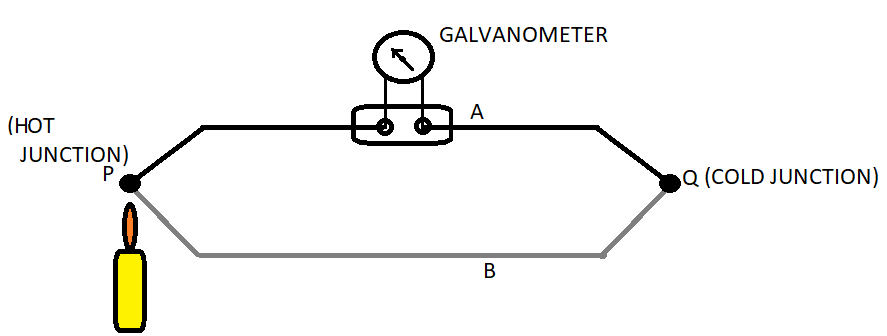
The thermocouple is based on the principle of:
A) Seebeck effect
B) Thomson effect
C) Peltier effect
D) Joule effect
Answer
219.6k+ views
Hint: A thermocouple is a sensor for measuring temperature. This sensor consists of two dissimilar metal wires, joined at one end, and connected to a thermocouple thermometer or other thermocouple-capable device at the other end.
A small thermoelectric current is generated when two different metal wires are put into contact at both ends with their junctions having a different temperature.
Complete answer:
Two dissimilar metals ‘A’ and ‘B’ are joined at the two junctions ‘P’ and ‘Q’. Here the ‘P’ junction is a hot junction whereas the junction ‘Q’ is a cold junction and a galvanometer is connected in this arrangement as shown in Figure.

When these junctions are kept at different temperatures, generally cold junction is kept at $0^\circ $C and the hot junction is kept at an unknown temperature which we want to measure (i.e. the temperature of the junction is raised by heating it). An e.m.f. will be generated in this circuit due to the temperature gradient along the wire across the junctions.
When both the junctions are at different temperatures, a current will flow through the meter and the meter will show the deflection.
As the generated e.m.f. is proportional to the temperature difference, the amount of current flow will also be proportional to the temperature difference.
The working principle: Seebeck Effect
Seebeck Effect: This effect states that when a closed circuit is formed by joining two dissimilar metals at two junctions, and junctions are maintained at different temperatures then an electromotive force (e.m.f.) is induced in this closed circuit.
Final answer is A, Seebeck Effect.
We can see that in a thermocouple two dissimilar wires or electrical conductors are joined and a temperature difference is created between the junctions by heating one junction thus this temperature gradient produces a voltage difference between two junctions and the current starts flowing. This is the Seebeck effect.
Note: At the hot junction, electrons get energy and start moving towards the cold junction and this results in the flow of current in the thermocouple
When both the junctions are at the same temperature, e.m.f. generated at both junctions will be the same. No current will flow through the circuit. And there will be no deflection in the meter.
The amount of induced e.m.f. is different for different metal combinations and is proportional to the temperature difference of the junctions.
A small thermoelectric current is generated when two different metal wires are put into contact at both ends with their junctions having a different temperature.
Complete answer:
Two dissimilar metals ‘A’ and ‘B’ are joined at the two junctions ‘P’ and ‘Q’. Here the ‘P’ junction is a hot junction whereas the junction ‘Q’ is a cold junction and a galvanometer is connected in this arrangement as shown in Figure.

When these junctions are kept at different temperatures, generally cold junction is kept at $0^\circ $C and the hot junction is kept at an unknown temperature which we want to measure (i.e. the temperature of the junction is raised by heating it). An e.m.f. will be generated in this circuit due to the temperature gradient along the wire across the junctions.
When both the junctions are at different temperatures, a current will flow through the meter and the meter will show the deflection.
As the generated e.m.f. is proportional to the temperature difference, the amount of current flow will also be proportional to the temperature difference.
The working principle: Seebeck Effect
Seebeck Effect: This effect states that when a closed circuit is formed by joining two dissimilar metals at two junctions, and junctions are maintained at different temperatures then an electromotive force (e.m.f.) is induced in this closed circuit.
Final answer is A, Seebeck Effect.
We can see that in a thermocouple two dissimilar wires or electrical conductors are joined and a temperature difference is created between the junctions by heating one junction thus this temperature gradient produces a voltage difference between two junctions and the current starts flowing. This is the Seebeck effect.
Note: At the hot junction, electrons get energy and start moving towards the cold junction and this results in the flow of current in the thermocouple
When both the junctions are at the same temperature, e.m.f. generated at both junctions will be the same. No current will flow through the circuit. And there will be no deflection in the meter.
The amount of induced e.m.f. is different for different metal combinations and is proportional to the temperature difference of the junctions.
Recently Updated Pages
Chemical Equation - Important Concepts and Tips for JEE

JEE Main 2022 (July 29th Shift 1) Chemistry Question Paper with Answer Key

Conduction Explained: Definition, Examples & Science for Students

Analytical Method of Vector Addition Explained Simply

Atomic Size - Important Concepts and Tips for JEE

JEE Main 2022 (June 29th Shift 1) Maths Question Paper with Answer Key

Trending doubts
JEE Main 2026: Application Form Open, Exam Dates, Syllabus, Eligibility & Question Papers

Understanding Uniform Acceleration in Physics

Derivation of Equation of Trajectory Explained for Students

Hybridisation in Chemistry – Concept, Types & Applications

Understanding the Angle of Deviation in a Prism

Understanding Collisions: Types and Examples for Students

Other Pages
JEE Advanced Marks vs Ranks 2025: Understanding Category-wise Qualifying Marks and Previous Year Cut-offs

Units And Measurements Class 11 Physics Chapter 1 CBSE Notes - 2025-26

NCERT Solutions For Class 11 Physics Chapter 8 Mechanical Properties Of Solids

Motion in a Straight Line Class 11 Physics Chapter 2 CBSE Notes - 2025-26

NCERT Solutions for Class 11 Physics Chapter 7 Gravitation 2025-26

Mechanical Properties of Fluids Class 11 Physics Chapter 9 CBSE Notes - 2025-26




